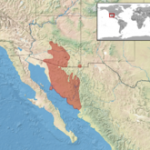Tiger rattlesnake is a highly poisonous species of snake, occurring in the southwestern United States and northwestern Mexico. The species is terrestrial, but it is an adept swimmer and is also found above the ground. It becomes diurnal and crepuscular during the fall season.
| Kingdom |
Animalia |
| Phylum |
Chordata |
| Subphylum |
Vertebrata |
| Class |
Reptilia |
| Order |
Squamata |
| Suborder |
Serpentes |
| Family |
Viperidae |
| Subfamily |
Crotalinae |
| Genus |
Crotalus |
| Scientific Name |
Crotalus tigris |
| Other Names |
Tiger Rattler |
| Length |
Up to 35 in |
| Color |
Gray, lavender, pink, blue-gray or buff ground color with pink, cream or pale orange on the sides |
| Distribution |
Central Arizona (United States), Mexico |
| Habitat |
Rocky desert canyons, foothills, vegetation zones such as thornscrub, grassland, chaparral, tropical deciduous forest |
| Diet |
Rodents, lizards |
| Hibernation Fact |
Hibernate during late fall and winter in animal burrows or rock crevices |
| Predators |
Hawks, eagles, coyotes, other snakes |
| Venom Fact |
Venom consists of myotoxin and neurotoxin |
| Breeding Season |
End of may to middle of August |
| Mode of Reproduction |
Ovoviviparous (producing young by means of eggs hatched inside the body of the parent) |
| Litter Size |
Around 5 young |
| Average Lifespan |
Up to 15.3 years in captivity |
| IUCN Conservation Status |
Least Concern |
Tiger Rattlesnake Pictures Gallery
-

-
Crotalus Tigris
-

-
Images of Tiger Rattlesnake
-

-
Tiger Rattler
-

-
Tiger Rattlesnake Images
-

-
Tiger Rattlesnake Photos
-

-
Tiger Rattlesnake Pictures
-

-
Tiger Rattlesnake Range
-

-
Tiger Rattlesnake Venom
-

-
Tiger Rattlesnake
-

-
Tiger Rattlesnakes















